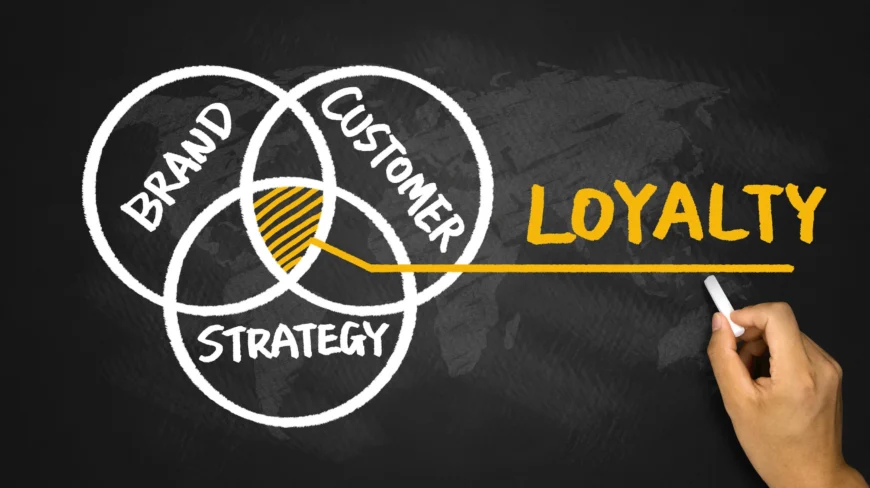In today’s highly competitive business landscape, establishing a loyal customer base is vital for long-term success. Brand loyalty plays a crucial role in achieving this objective. In this article we will look at what brand loyalty is, at what levels it can manifest itself, why it is so important, and effective strategies for building and developing brand loyalty.
Elevating brand loyalty leads to increased customer retention, which is often more cost-effective than acquiring new customers. Loyal customers not only spend more but also become brand ambassadors, advocating for the brand to their peers. Understanding and nurturing this loyalty can be the cornerstone of a brand’s longevity and market dominance. For more on modern branding solutions, visit https://www.outcrowd.io/branding-page.
What is Brand Loyalty?

Brand loyalty refers to the deep emotional connection and commitment that customers develop towards a particular brand, product, or service. It goes beyond repeat purchases and signifies a strong preference for the brand over its competitors. Loyal customers are more likely to choose the same brand consistently, even when facing various alternatives in the market.
This consistent choice often translates to increased revenue for businesses. Furthermore, a strong loyalty foundation can serve as a buffer during market downturns. In essence, nurturing brand loyalty should be a top priority for all businesses aiming for sustained growth.
Levels of Brand Loyalty
- Cognitive Loyalty: At this level, customers exhibit a rational loyalty based on their perception of the brand’s superior features, quality, or pricing. They recognize the brand’s value and consciously choose it over others.
- Affective Loyalty: Affective loyalty emerges when customers develop an emotional bond with the brand. They feel connected to the brand’s identity, values, and purpose, which creates a sense of belonging and trust.
- Conative Loyalty: This is the highest level of brand loyalty. Conative loyalty refers to customers’ behavioral intention to repeatedly purchase from the same brand, showcasing a strong commitment to its products or services.
Why is Brand Loyalty Important?
Building brand loyalty holds immense significance for businesses due to several reasons:
- Customer Retention: Loyal customers are more likely to stick with a brand, reducing customer churn and fostering long-term relationships.
- Positive Word-of-Mouth: Satisfied and loyal customers become brand advocates, sharing their positive experiences with others, which amplifies the brand’s reach in the market.
- Competitive Advantage: A loyal customer base provides a competitive edge, as competitors find it challenging to sway customers who have a strong emotional attachment to the brand.
- Revenue Growth: Loyal customers tend to spend more and are less price-sensitive, contributing to steady revenue growth and improved profitability.
How to Build Brand Loyalty

- Exceptional Customer Service: Providing top-notch customer service is crucial in creating a positive brand experience. Businesses should aim to exceed customer expectations and promptly address any concerns or issues to foster a sense of care and appreciation.
- High-Quality Products and Services: Consistently delivering high-quality products or services instills trust and confidence in the brand, encouraging customers to remain loyal.
- Emotional Branding: Building an emotional connection with the audience is key to cultivating brand loyalty. This can be achieved through storytelling, aligning the brand with meaningful causes, and showcasing the brand’s human side.
- Personalization: Tailoring products or services to individual customer preferences enhances their satisfaction and makes them feel valued, ultimately contributing to stronger brand loyalty.
- Loyalty Programs: Implementing loyalty programs with rewards, discounts, or exclusive offers encourages repeat purchases and helps nurture customer loyalty.
- Engaging Content: Creating relevant and engaging content, such as blogs, social media posts, and videos, can strengthen the brand-customer relationship and keep the audience connected to the brand’s identity.
- Community Building: Establishing a sense of community among customers can foster brand loyalty. Encouraging interactions, user-generated content, and online forums can create a loyal customer community.
The Evolution of Brand Loyalty in the Digital Age
In the age of technology, brand loyalty has transcended beyond mere product satisfaction. With consumers having vast amounts of information at their fingertips, they’re not just loyal to what works – they’re loyal to what resonates. In the digital age, consumers prioritize experiences, personalization, and a sense of community. They are more likely to stick with brands that demonstrate shared values, engage authentically on social platforms, and provide seamless digital experiences. Additionally, the rise of influencer marketing has given consumers relatable figures to connect with, further shaping their loyalties. Brands that are agile, authentic, and adept at navigating digital landscapes not only foster loyalty but also create brand ambassadors out of their most dedicated customers.
Challenges to Maintaining Brand Loyalty
In today’s hyper-competitive market, brand loyalty faces many challenges. Consumers are overwhelmed with choices, making it easy for them to switch preferences based on price, convenience, or novelty. Add to this, the impact of social media and online reviews: a single negative review or a viral negative sentiment can tarnish a brand’s reputation overnight. Moreover, younger generations, such as Gen Z and Millennials, often prioritize experiences over products and value authenticity, making traditional loyalty-building strategies less effective. To overcome these challenges, businesses must continuously innovate, stay authentic to their core values, maintain a two-way communication channel with customers, and ensure consistent high-quality experiences across all touchpoints.
Measuring the ROI of Brand Loyalty Programs

For businesses, understanding the return on investment (ROI) of their loyalty initiatives is crucial. But measuring the effectiveness of brand loyalty isn’t just about tracking sales or repeat business. It’s about understanding customer lifetime value, the cost of acquiring a new customer versus retaining an existing one, and the intangible benefits such as word-of-mouth referrals and brand advocacy. Modern analytics tools offer insights into customer behavior, allowing businesses to fine-tune their loyalty programs. Segmenting loyal customers, tracking their purchase patterns, and monitoring their engagement levels can provide valuable data. By effectively analyzing this data, businesses can adapt their strategies to maximize ROI, ensuring that their loyalty programs not only retain customers but also promote sustainable growth.
Final Thoughts

In conclusion, brand loyalty is a powerful force that can significantly impact a business’s success in the market. By understanding the levels of brand loyalty and employing effective strategies to build and maintain it, businesses can create a devoted customer base that supports and advocates for the brand, ultimately driving long-term growth and prosperity.




